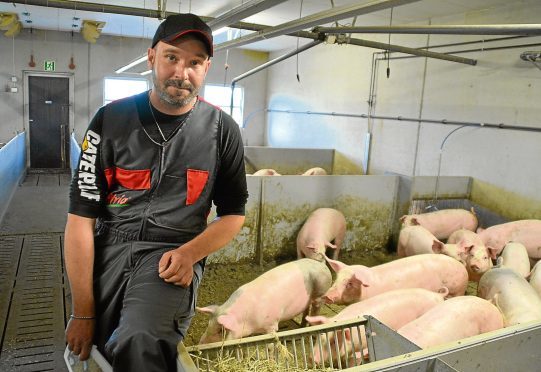Having Russia as a close neighbour is proving a real challenge for Finland’s farmers as it depended on the Soviet nation as a vital customer for exported farm produce.
Since Russia introduced the ban on European produce in 2014, depressing prices, Finland’s pig industry has felt its fair share of the pinch.
Young farmer Mika Vuorinen is a fourth-generation producer who has been farming at Jalasjarvi, 150km north of Tampere, since 2006.
The farm has been in his family since 1914 and extends to 247 acres owned and another 257 acres of rented land.
Mika, 37, produces 6,500 pigs per year in his wean to fattening system which can hold 1,700 pigs at maximum capacity.
The most recent unit was built in 2012 and holds 1,300 pigs and a second older unit, renovated in 2013, holds 400 pigs.
Piglets bought for the farm are a three breed cross born from F1 generation sows, which are a crossbreed of Landrace and York breeds chosen for their good reproduction and parental characteristics.
Boars are of the Duroc breed used for good growth rates.
All of the pig breeding and genetics development on Mika’s farm has been carried out by Finnpig Oy, a company jointly owned by two major meat processing companies in Finland.
The farm has its own feed mixing unit combining barley and wheat with distiller’s grain and a feed concentrate manufactured by A-Rehu.
The feeding is all carried out by a fully automated liquid feeding system provided by the Pellon Group.
Mika grows barley and wheat for pig feed and then rapeseed, oats and rye are grown for crop rotation.
He receives 650 euros (£580) per hectare for the arable land in a subsidy from the EU and a small payment from the Finnish government as a subsidy for the pigs.
The pighouses are heated with a special heat exchange system that draws energy from the slurry, which in turn warms up water that is circulated around the pens.
A total of 650,000 euros (£581,047) was invested in the new buildings with 25% of this being subsidised by the Finnish government.
Every two weeks Mika buys pigs from the local meat production company Atria through three local birth to weaning units.
He takes them in at 31.8kg paying between 60 euros (£58.63) to 70 euros (£62.57) per head.
He then fattens these pigs and sells them at a carcase weight of around 90.3kg at 1.60 euros (£1.43) per kg in peak times but normally at an average of 1.40 euros (£1.25). It’s a system he has run for more than 10 years but with a current depression in the market Mika says he is too afraid to thoroughly examine his costs of production.
Atria says that on average Mika should be making an average between 10 euros (£8.93) and 15 euros (£13.40) profit per head taking everything into consideration but in reality he does not know as he is afraid to examine his costs too deeply.
“Pork prices at the moment go up and down quite often,” he said. “I buy the small pigs from Atria and then sell them back to Atria when fattened.
“I grow most of the feed for my pigs myself therefore trying to control some of my input costs but it’s difficult to think of what my overall costs are.”
Mika is married to Jaana and together they have three children, Annika, Ville and Vilma.
The farm has two full-time employees and two part-time seasonal workers.
“We got together with three other farms to pool our labour and machinery for crop production,” said Mika.
“We have our own tractors and a combine, but other cultivating machinery and a grain drier are shared.
“Time and resources permitting, we contract harvest for four other farmers as well.”
But prices have been hit hard by the ongoing Russian ban on food from the EU.
Mika added: “Since Russia has banned European food imports, partially due to African swine fever, but in reality as a counter measure for EU restrictive measures in response to the crisis in Ukraine, the Finnish pig industry has been hit hard.
“Prices dipped below the cost of production, and even though Finland is very efficient, it is challenging to make a profit in this business.
“It is vital to have several supporting incomes on the farm, along with the pork production, to survive bad years.”
